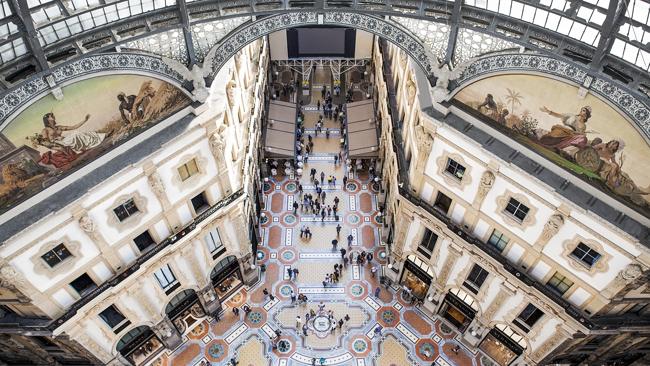Franchising, retail, business

02/05/2015
Shafts of spring sunlight fall through the glass dome on to the creamy walls and honey-coloured masonry of Milan’s 19th-century Galleria Vittorio Emanuele II, one of the oldest and grandest shopping malls in Europe.
Flanked by La Scala opera house and the Duomo, the Galleria is host to glamorous fashion shops and restaurants. It is also the reason for a unique partnership between two of Milan’s biggest fashion brands. Rivals Prada and Versace joined forces to fund the €3 million ($4m) 13-month restoration of the Galleria, its deadline for completion the start of the World Expo in Milan this weekend.
Built in 1865-67 and named for the first king after the unification of Italy in 1861, the Galleria is a famous meeting place, says Paolo Gasparoli, the architect guiding the restoration: “It is the living room of the Milanese.”
The romantic architecture and frescoes are entrancing but when Versace recently moved into the retail space opposite Prada in the arcade, it was surprised to uncover hidden gems. “As soon as the work began to renovate the space ... capitals, friezes and countless other original decorations that survived the bombings of World War II were discovered,” says Versace chief executive Gian Giacomo Ferraris.
This is just one of the many examples of big fashion houses making a decisive contribution to restoring Italy’s great artworks and archeological monuments. One of the biggest and most widely publicised is the €25m restoration of the 2000-year-old Coliseum in Rome, funded by luxury fashion tycoon Diego Della Valle of Tod’s Group. Other projects are being underwritten by Bulgari, Fendi, Gucci, Ferragamo and Diesel founder Renzo Rosso, a native of the Veneto region, who found €5m for the restoration of Venice’s Rialto Bridge.
Such philanthropy has become a necessity for Italy, which saw funding for the cultural sector slashed to €1.4 billion last year — peanuts, given the country has more World Heritage Sites than any other. In March last year, after a series of wall collapses at Pompeii, Prime Minister Matteo Renzi called on private investors to help restore and maintain heritage monuments. “Italy is a country of culture and so I challenge businessmen,” he said. “What are you waiting for?”
The luxury fashion brands now see it as an act of civic responsibility to protect their national heritage, but given Italy has 50 listed World Heritage Sites, that would mean selling a whole lot more jewellery, fashion and handbags. So where do they start? The answer seems to be in hometown heritage, which for Bulgari and Fendi means Rome. Work starts soon on the two-year project to refurbish the Spanish Steps, with Bulgari picking up the €1.5m bill. Bulgari Group chief Jean-Christophe Babin says the steps “lie at the heart of our story”. The 136 baroque-style steps connect Bulgari’s first shop, founded in 1884 in Via Sistina, with its present boutique in the Via Condotti. Bulgari’s Milan hotel displays images of the steps during Rome’s glamorous heyday in the 1950s-60s.
There are also images of Anita Ekberg frolicking in La Dolce Vita in the Trevi Fountain, another icon that has needed repair. The 18th-century fountain featuring the central Oceanus statue by Pietro Bracci started to shed chunks of stone and plaster three years ago; Fendi stepped in to pay for the restoration and in February this year the fountain’s facade and statue were completed. “It’s the first time we have been involved in something so big, but we have always supported things in a quiet way, both Fendi and personally,” says Silvia Fendi.
Plenty of the luxury bags and shoes sold by Florentine powerhouses Salvatore Ferragamo and Gucci have gone into helping their city, with several projects over recent years. Ferragamo’s latest is a pledge of €600,000 to restore some areas of the Uffizi Gallery. “We wanted to do something that would improve the city … and we were looking for a project that would be long lasting,” the company’s president Ferruccio Ferragamo has told Women’s Wear Daily.
Gucci used the proceeds from the Gucci Museo to pay for the refurbishing of 10 exquisite Renaissance tapestries commissioned by Cosimo de Medici in the 16th century from artists Jacopo Pontormo and Agnolo Bronzino, which are being reunited in a special Milan Expo exhibition called The Prince of Dreams.
All these acts of philanthropy, however, are dwarfed by the huge undertaking Tod’s has made to restore the Coliseum. Della Valle remembered visiting the amphitheatre in Rome as a 13-year-old and being captivated by the stories of chariot races and gladiators. Now, decades later, he is a force behind the restoration of the ruins, scheduled to be completed by mid-2016.
“We hope this important initiative encourages other companies and private patrons proud of our culture and country to follow,” says Della Valle, who sees this act of philanthropy as his “duty”. Ensuring the preservation of Italy’s culture for future generations, he says, strengthens the nation’s “image and credibility worldwide”.
Fonte:http://www.theaustralian.com.au/life/versace-prada-tods-bulgari-fendi-gucci-protect-italys-heritage/story-e6frg9zo-1227328350843